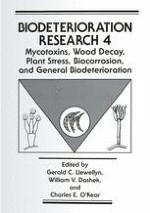
1994 | OriginalPaper | Buchkapitel
Cone Analysis of Pinus Taeda L. (Loblolly Pine) Clones
verfasst von : Roslyn A. March, David L. Bramlett, John E. Mayfield, William V. Dashek
Erschienen in: Mycotoxins, Wood Decay, Plant Stress, Biocorrosion, and General Biodeterioration
Verlag: Springer US
Enthalten in: Professional Book Archive
Aktivieren Sie unsere intelligente Suche, um passende Fachinhalte oder Patente zu finden.
Wählen Sie Textabschnitte aus um mit Künstlicher Intelligenz passenden Patente zu finden. powered by
Markieren Sie Textabschnitte, um KI-gestützt weitere passende Inhalte zu finden. powered by
Loblolly pine is the most important forest tree species in the Southeastern United States, producing the major volume of both commercial timber and pulpwood for the region. Inadequate regeneration of this species has been identified as one of the causes of lower yields of softwood in the Southeast. Part of the solution would be a readily available seed supply for forest nurseries. In the mid 1950’s, an intensive program was initiated to produce genetically improved seeds from loblolly pine for reforestation of harvested stands. Scions from superior phenotypes in natural stands were grafted onto seedlings and clonal seed orchards were established (Zobel et al., 1958). Even with substantial insect and disease protection, annual seed losses are observed. Any seed loss has an economic effect because of the high value of the genetically improved seed. The objective of the present investigation was to evaluate seed production efficiency in the Georgia Forestry Commission’s Arrowhead Seed Orchard, Pulaski County, Georgia. Here, we report data regarding analysis of cones collected from clones in the seed orchard. Analysis of 21 sample trees revealed that two clones, 558 and 593, were the most productive based upon seed efficiency data. In some ovules, the deterioration of the ovular contents began in June and resulted in the production of “empty seeds”.